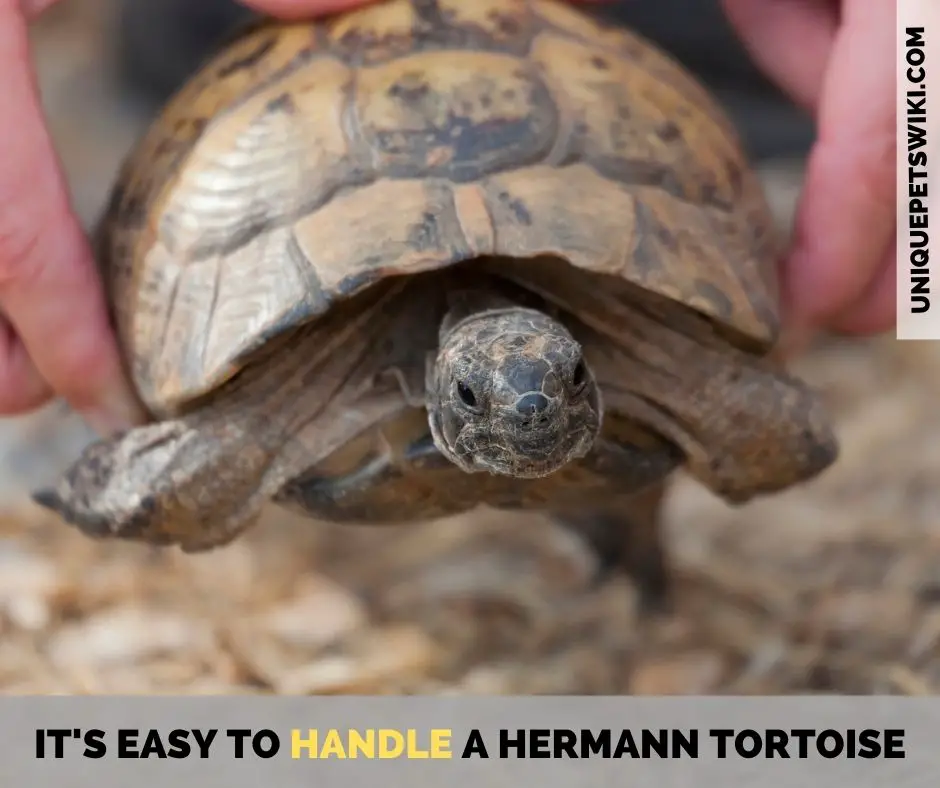Sulcata vs. Hermione tortoise, which is better? There are many factors that pet owners consider before buying their pets. When pet love is a reason enough for owning these pets, the ability to care for them should be a priority.
For pet enthusiasts to take good care of these pets, it is necessary to know their responsibilities towards the pets. Caring for wild pets requires even more commitment.
Tortoise enthusiasts may face challenges when choosing the best species to keep in captivity. Sulcata and Hermann are popular tortoise pets. They are both known for their calm and gentle personality.
They have other different characteristics that may result in one being better than the other, especially for beginners.
Therefore, in this article, we will be comparing sulcata and Hermann tortoises. We will tell you everything you need to know about these popular tortoise pets.
Keep reading!
Contents
Sulcata vs. Hermione Tortoise as Pets
Sulcata and Hermann tortoises are famous among tortoise enthusiasts. They are both gentle and calm. However, Hermann tortoises are even better pets as they can quickly bond with their owners.
Helping tortoise enthusiasts choose their best pet is excellent. But, guiding and informing them about these pets is even better.
Therefore, in this article, we will not only help you choose the best pet between the two, but we will guide and inform you, making it easier for you to pick the best.
Sulcata vs. Hermione (Hermann) Tortoise: Full Comparison
Sulcata and Hermione tortoises make lovely pets. They both have a long lifespan, and their personality is almost similar.
Even so, their physical appearances are different. Sulcata tortoises are larger compared to Hermann.
Additionally, Hermann tortoise’s orange-yellow shell makes them appear more attractive. Let’s look at other critical factors to consider when choosing the best beginner-friendly pet for you between the two.
Lifespan
Lifespan refers to the amount of time that your pet is likely to live before they die. Sulcata and Hermann tortoises have a long lifespan. However, sulcata have a longer lifespan compared to Hermann.
Sulcata tortoises can live for up to 100 years, while Hermann’s average lifespan is 75 years.
Habitat
Sulcata tortoises are natives of the South Saharan deserts. They are widely spread in Mauritania, Chad, Sudan, Senegal, and Niger.
The climate in those areas is harsh, especially during the day. Thus, sulcata tortoises dig large tunnels, which they use to hide from the scorching sun.
On the other hand, Hermann tortoises are natives of Mediterranean evergreen and oak forests.
They mostly live in rocky hill slopes, herbaceous shrub, grass hillsides, scrubby vegetation.
The climate in those areas is moist, especially during the spring and fall, but also very dry in the summer.
Size

There is a significant difference between sulcata tortoises and Hermann tortoises when it comes to their size.
Sulcata tortoises are the third most giant tortoises in the wild, while Hermann are middle-sized tortoises.
Sulcata tortoise adult size is 25-30 inches, while Hermann maximum adult size is 10-12 inches, depending on species. Testudo Hermann species are smaller than boettgeri.
Weight
Sulcata and Hermann tortoise weight is also significantly different. Hermann tortoises weigh less compared to sulcatas.
The average Hermann adult weight is 6.6-8.1 pounds. On the contrary, sulcata tortoise’s average weight is 150- 200 pounds.
Looks
Sulcata tortoises are not only different from Hermann in sizes and weight but also in physical looks.
Sulcata tortoises have thick yellowish-brown skin and yellow to brown shells. And their front legs have pointed scales.
As for the Hermann, they appear with an intense yellow color against a dark background. They might also occur with a yellow speck on the cheek, and their heads colors vary from olive to yellow.
Another unique character about Hermann tortoises is their divided supracaudal scute.

Active Level
Hermann tortoises are pretty active. Even though they are known to be gentle and calm, they enjoy climbing, digging, foraging and sunbathing.
Just like the Hermann tortoises, sulcata tortoises are also active and curious. Therefore, you should provide secure places to move around as they quickly get stuck in small spaces during escapades.
Diet
All tortoises almost have a similar diet. However, tortoises feed on what is available in their habitat.
Therefore, even though both tortoises are herbivorous, Hermann tortoises are known to feed on vertebrates occasionally.
In captivity, dark leafy greens will make an excellent diet for Hermann tortoises. Generally, a diet rich in fibre and low in proteins and fats should work great for both tortoises.
Additionally, you can occasionally offer fruits to these tortoises. And brush-up their diet with calcium and vitamin supplements.

Brumation
When temperatures significantly go down, especially during winter, most tortoises, including Hermann, enter the brumation period.
Brumation helps them retain their weight when the weather is unfavourable, and it’s hard for them to reach their optimal digestive temperature.
However, sulcata tortoises do not brumate. Instead, they slow down and eat less during these seasons.
Personality
Hermann and sulcata tortoises are docile, calm, and friendly. However, Hermann tortoises are capable of developing a bond with their owners, unlike the sulcatas.
Even so, their personality varies from one tortoise to another. Therefore, you may encounter one bold tortoise willing to bond and another shy that would rather hide.
Therefore, sulcata and Hermann equally make great pets in terms of personality.
Required Enclosure Size
The size of an enclosure goes hand in hand with the size of the pet. Therefore, the larger the pet, the larger the enclosure will be required.
Regarding this, sulcata will require a larger enclosure compared to Hermann tortoises.
The ideal enclosure for Hermann adult tortoise should be at least 46 inches in length.
On the contrary, a sulcata tortoise adult enclosure should not be less than 216 inches or 18 feet. Thus, it isn’t easy finding an enclosure large enough to hold these massive tortoises.
Lighting, Heating, Humidity Requirements
Lighting, heating, and humidity are critical to keeping tortoises healthy and comfortable in captivity.
The amount of these requirements depends on the tortoise’s natural habitat.
Lighting
UVB lighting is critical for tortoises to synthesize vitamin D3 into their skins. And, vitamin D3 helps them to absorb calcium which is necessary for bone structure.
To provide adequate lighting for both tortoises, you can use a T5 tube as it produces more light.
Heating
Unlike lighting, heating temperature should differ for both tortoises as they live in different habitats.
For instance, Hermann tortoises live in the Mediterranean, where the climate is not as harsh as in Southern Saharan, where Sulcatas live.
As such, to keep Hermann tortoises healthy and comfortable, you should provide a heating temperature of 60-850F on the cooling side and 90-950F on the basking spot.
You can let the temperature fall to 40-750F at night.
As for the sulcatas, they live in areas where the climate is scorching. Therefore, their heating temperature should range between 77-950F on the cooling side and 110-1220F on the basking spot.
At night, the temperature should never go below 630F.
Humidity
Humidity is also very significant for sulcata and Hermann tortoises. These tortoises require different ranges of humidity.
The suitable humidity for Hermann tortoises is 60-85%. Hatchlings require a higher percentage of moisture than adults.
As for the sulcata tortoises, they require humidity ranging between 40-60% during the day. It would help if you misted their substrate during the night to raise the humidity to 70 or 80%.
Suitability for Beginners

Sulcata and Hermann tortoises make lovely pets. However, beginners might find sulcata tortoise’s size overwhelming.
Therefore, if you are also a beginner and this massive tortoise makes you uncomfortable, Hermann can be more suitable for you.
Costs
Sulcata tortoises can cost between $300-1000. The cost of one sulcata depends on their sex and species.
For instance, female sulcatas are more expensive than males. Additionally, some species such as ivory and albino cost more than others.
Hermann tortoises are not as costly as the sulcatas. However, they are not cheap either.
The cost of Hermann tortoise ranges between $150-900 depending on age and species.
Ability to Keep In Groups
It is possible to keep 2-3 females and one male Hermann in groups. But, it is inadvisable to keep one male and a female together as they get overly aggressive when they want to mate.
You should never keep more than one male together as they are territorial and can fight to the death.
As for the sulcatas, it can also be fine if you were to put females together. However, since these tortoises are giant and require vast space to keep one, it can be costly to keep more than one.
Additionally, tortoises are solitary and prefer to stay alone unless during breeding.
Can you Keep Sulcata and Hermann Tortoise together?
Some tortoises are immune to some parasites and diseases, while others are not. Thus, no, you should not keep sulcata and Hermann tortoises together.
Besides, they have different heating and humidity requirements. Therefore, keeping them together can lead to either getting ill due to unsuitable habitat.
Wrapping Up
Sulcata and Hermann tortoises make wonderful pets even for beginners. They are calm, docile, friendly, and hardy.
The only significant difference between them is size, weight, and habitat requirements.
Therefore, whichever tortoise you may choose should be easy to care for and maintain.
We wish you all the best!
